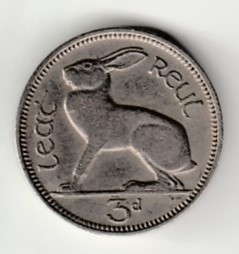The Hound Of Éire: 6 Pence (Ireland, 1942)-Article
- smithwicknumismati
- Aug 11, 2021
- 2 min read
Updated: Apr 12, 2024
This Irish coin is a pre-decimal Six Pence, dated 1942. The Irish Six Pence represented the 5th denomination denomination, of the pre-decimal Irish Pound. With the Farthing (¼ Penny), Half Penny , Penny and Three Pence representing the smaller denominations.
The pre-decimal Three Pence entered circulation in 1928 and was last minted in 1968. The 1942 design Three Pence was introduced due to the rising cost of nickel during WWII (1939-1945). Replacing the previous and short-lived 1939-1940 Three Pence, which used nickel-only design. It ceased being legal currency on 31 December 1971, becoming obsolete due to decimalization.
The coin is a plain-edged design made of a cupronickel alloy (75% copper/25% nickel) and weighs 3.24 g. Its dimensions are 17.7 mm (0.670 in) wide and 1.9 mm (0.075 in) thick. This coin will be reviewed reverse first, note the observe (Harp) is often mistaken for the reverse (Irish Hare).
Observe

The “Irish Hare” reverse was designed English artist Percy Metcalfe, CVO, RDI. It features a siting Irish Wolf Hound, a visible ground line can be seen. Percy Metcalfe's initials (PM) are present on the lower right, below the ground line. Also below the hound is the words reul, and above is the denomination. Expressed as “6d”, derived from the Roman dēnārius.
Notably 1 "reul" was an equivalent to Sixpence. The term "reul" being a Irish/Gaeilge variant of Spanish "real" (1/4 Peseta). Which was popular coin of roughly similar value to the Sixpence.
Reverse

The Observe features the “Queen Mary Harp” (Clàrsach na Banrìgh Màiri), the national symbol of Ireland. To the left is the name Éire, the Irish/Gaeilge name for Ireland. To the right is the coin's minting year (1942). Notably Irish Six Pence from 1928 to 1937, had their date split to both sides of the harp. Along with name Saorstát Éireann, for Irish Free State. (Example: Left-side (Saorstát 19), Right-side (Éireann 28)
Pre-Decimal Irish Pound Guide
10 Florin = 1 Irish Pound
20 Shilling = 1 Irish Pound
240 Penny = 1 Irish Pound
960 Farthing = 1 Irish Pound
Size Comparison













Comments